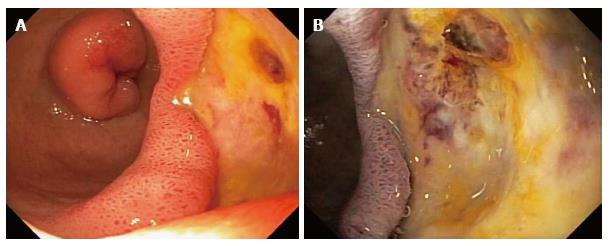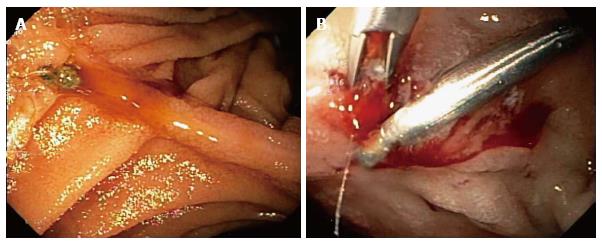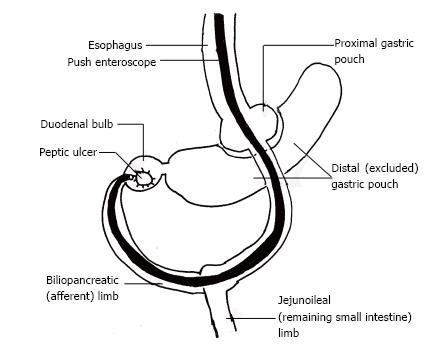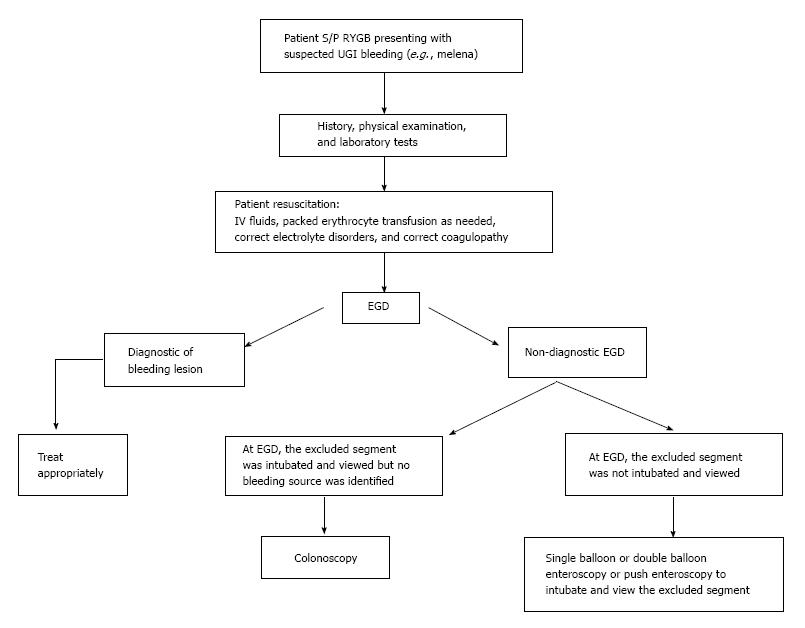Copyright
©The Author(s) 2017.
World J Gastrointest Endosc. Oct 16, 2017; 9(10): 521-528
Published online Oct 16, 2017. doi: 10.4253/wjge.v9.i10.521
Published online Oct 16, 2017. doi: 10.4253/wjge.v9.i10.521
Figure 1 Endoscopic findings and therapy during single balloon enteroscopy in Case 1.
A: Diagnostic findings. Single balloon enteroscopy performed in a 44-year-old woman, status post Roux-en-Y gastric bypass (RYGB) surgery 11 years earlier for morbid obesity, who presented with acute melena and a hemoglobin decline to 5.8 g/dL demonstrates a 4-cm-wide bulbar ulcer with a non-bleeding visible vessel in the afferent limb. Note the retrograde view of the duodenal bulb with the pylorus seen in the distance. Esophagogastroduodenoscopy performed 3 d earlier for melena had revealed no upper gastrointestinal lesions, but the afferent limb of the Roux-en-Y, including the excluded proximal duodenum and stomach, had not been intubated and visualized because of technical difficulties at esophagogastroduodenoscopy; B: Endoscopic therapy. Single balloon enteroscopy showing the ablated bulbar ulcer after dual therapy of dilute epinephrine injection and heater probe thermocoagulation.
Figure 2 Endoscopic findings and therapy during push enteroscopy in Case 2.
A: Diagnostic findings. Push enteroscopy performed in a 64-year-old woman status post RYGB surgery 10 years earlier for morbid obesity who presented with acute melena and a hemoglobin of 5.1 g/dL demonstrates a 5-mm-wide bulbar ulcer, which is actively oozing blood. EGD performed 5 d earlier for melena had revealed no upper gastrointestinal lesions, but the afferent limb of the Roux-en-Y, including the excluded proximal duodenum and stomach, had not been intubated and visualized because of technical difficulties at EGD; B: Endoscopic therapy. Push enteroscopy showing the bulbar ulcer after endoscopic treatment with dilute epinephrine, argon plasma coagulation, and hemoclips. RYGB: Roux-en-Y gastric bypass; EGD: Esophagogastroduodenoscopy.
Figure 3 Sketch showing coronal axis of upper gastrointestinal tract during intubation of afferent (biliopancreatic) limb using a push enteroscope in a patient status post Roux-en-Y gastric bypass for morbid obesity.
After Roux-en-Y gastric bypass (RYGP) direct continuity between the proximal and distal stomach is severed and the stomach is surgically divided and reconstructed to form two pouches: A small proximal gastric pouch that connects directly to the proximal jejunum via a surgical anastomosis (efferent limb) and a large distal pouch that connects retrograde only to the duodenum via the duodenal bulb (afferent limb). Surgical reconstruction of a small proximal gastric pouch promotes weight loss by causing early satiety due to limited proximal gastric pouch capacity, and by causing decreased appetite by reducing ghrelin synthesis. The sketch shows that the afferent (biliopancreatic) limb is hard to reach and intubate using a routine esophagogastroduodenoscope after RYGP because of the long distance traversed (through the jejunum) to reach the afferent limb, and sharp angulation at the anastomosis between the afferent and efferent limbs. Failure to intubate the afferent limb results in missing lesions in this limb, as occurred in the 2 currently reported cases in which duodenal bulb ulcers with high risk stigmata of recent hemorrhage were missed.
Figure 4 Flow diagram showing a proposed diagnostic/therapeutic algorithm for patients status post Roux-en-Y gastric bypass surgery presenting with acute gastrointestinal bleeding that is highly likely from an upper gastrointestinal source (e.
g., patient presenting with melena). The important difference in this algorithm from a general patient with UGI bleeding (who is not status post RYGB) is the addition of push enteroscopy, single balloon enteroscopy, or possibly double balloon enteroscopy if the EGD was non-diagnostic but the excluded stomach and duodenum (afferent limb) had not been intubated and viewed at EGD. Alternative management algorithms include: (1) performing push enteroscopy or single balloon enteroscopy initially instead of EGD in patients status post RYGB; or (2) performing colonoscopy before performing push enteroscopy or single balloon enteroscopy (or double balloon enteroscopy) after a non-diagnostic EGD. RYGB: Roux-en-Y gastric bypass; EGD: Esophagogastroduodenoscopy.
- Citation: Hakim S, Reddy SRR, Batke M, Polidori G, Cappell MS. Two case reports of acute upper gastrointestinal bleeding from duodenal ulcers after Roux-en-Y gastric bypass surgery: Endoscopic diagnosis and therapy by single balloon or push enteroscopy after missed diagnosis by standard esophagogastroduodenoscopy. World J Gastrointest Endosc 2017; 9(10): 521-528
- URL: https://www.wjgnet.com/1948-5190/full/v9/i10/521.htm
- DOI: https://dx.doi.org/10.4253/wjge.v9.i10.521












